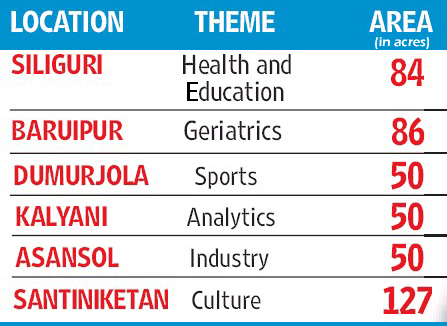With a view to playing a leading role in information technology and electronics in India, the Mamata Banerjee Government put out the West Bengal Policy on Information and Communication Technology, 2012 and the West Bengal ICT Intensive Scheme, 2012. Special emphasis has been placed in the fields of hardware, gaming and animation.
The various aspects stressed upon as part of the policy include setting up information technology centres in the districts, proliferating the hardware and electronics industries, setting up national centres of education, setting up centres of excellence in information technology, taking up new e-governance initiatives, taking up e-district projects through which, among other things, all villages would be getting the benefits of Government schemes vis e-kiosks, turning all State Government offices into e-offices, digitising all Government information in order to enable the Document Management System, setting up state-wide wide area networks (WANs), setting up a State data centre, setting up a full-fledged State portal and a State Service Delivery Gateway, creation special computer education kits for all State Government schools, etc.
In 2012, the State Government was awarded the Data Quest E-Readiness Award.
Huge increase in budgetary allocation
The yearly Budget allotment for the information technology and electronics sector by the Trinamool Congress Government has been much more when compared to the previous Left Front Government, which points to the serious intent of the present Government to develop this sector.
The Left Front Government, in its last four years, spent a total of Rs 16,39,41,000 whereas the Trinamool Government, in its first four years (2011-12 to 2014-15) has spent a total of Rs 299,48,64,000 (Rs 29,58,14,000, Rs 43,09,60,000, Rs 100,10,90,000 and Rs 126,70,00,000, respectively). This is a massive increase of 1,726.79% over the previous four-year period. The plan outlay for the present financial year (2015-16) is even more.
Information technology parks in eight districts
The State Government is setting up information technology (IT) parks in eight districts in 2015-16. In the last three years, 15 IT parks have been announced of which eight are on their way to completion. The eight are located in Siliguri, Durgapur, Asansol, Barjora, Rajarhat (near Kolkata), Kharagpur, Bolpur and Purulia. These eight would create employment opportunities for 20,000 people.
The other seven would be located in Malda, Howrah, Haldia, Kalyani, Krishnanagar, Taratala and Bantala (the last two are in Kolkata).
E-governance
Transparency in service, speed of service, efficiency of service – to ensure the implementation of these three aspects in all State Government work, the Trinamool Government has decided on e-governance as a backbone for implementation of all services and schemes.
- E-office schemes have been implemented in North and South 24-Parganas districts.
- E-office schemes have been implemented in North and South 24-Parganas districts.
- Staff Selection Commission and the Depart of Information and Technology have been converted into e-offices.
- As per the latest report, in 2013-14, Document Management Systems (DMS) have been implemented in 13 district magistrate offices.
- The same for the rest of the districts is going to be completed soon. For this purpose, 114 lakh documents would have to be scanned and stored digitally, 90% of which work is over.
- The departments of Urban Development, School Education, and Commerce and Industries have already had electronic file tracking systems implemented in 2013-14, and Home and Higher Education in 2014-15.
- Integrated Finance Management System (IFMS) has been implemented.
- Tracking of taxis through radio frequency identification (RFID) tags has been implemented.
- Information technology has been successfully used in the implementation of the Kanyashree project.
- For this creating and maintaining this IT backbone, about 500 departmental staff are working relentlessly.
E-districts
- The e-district project is being implemented through the digitization of 36 services.
- Of these 36, 16 have already been implemented as part of Phase-I.
- As part of Phase-I, over 200 block offices in nine districts have been connected with LAN technology.
- Project managers for the E-district project have been appointed in 17 districts.
IT majors setting up offices
- TCS is setting up offices spread over 40 acres in New Town-Rajarhat, where 3,500 are currently employed.
- Cognizant is setting up offices in the second Tower Complex in Bantala, where 5,000 would be employed.
- Unitech is setting up offices in Rajarhat.
- ITC has been given 17 acres in Rajarhat, where constructions are already underway.
Industrial and educational setups
- Land for electronics manufacturing clusters (EMCs) has been granted in Naihati and Falta.
- Work for a hardware park spread over 10 acres is on in Sonarpur; the work is going to be completed in the current financial year.
- An Indian Institute of Information Technology (IIIT) is coming up in Kalyani.
Employment
It is estimated that by the end of financial year 2015-16, 1,80,000 people would be employed in the IT and electronics sector, against the only 90,000 that got employment during the last year of Left Front rule (2010-11). On an average, employment in this sector is increasing by 20% annually.
IT in education
The State Government is implementing scholarship schemes online through State Service Delivery Gateway (SSDG). Computer systems with special education kits installed are being set up in schools in tribal regions. Schools for the blind are being supplied with state-of-the-art Braille monitor computers.
Hence, as we can see from the above information, the Maa-Mati-Manush Government of Chief Minister Ms Mamata Banerjee has had unprecedented success in the information technology and electronics sector.











